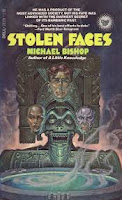The perception of Aztec and Mayan cultures is often of a war-like, bloodthirsty people who made ritual sacrifice quotidian. While there is historical evidence in support of this image, it doesn't paint the full picture. Slaves and prisoners weren't the only people sacrificed. The belief was that blood offerings forestalled the end of the world, meaning many people voluntarily offered their lives—people who wanted their heart removed, body disfigured, and ultimately death in the name of the cause. Examining this phenomenon in a science fiction setting is Michael Bishop's superb Stolen Faces (1977).
Stolen Faces is the tragic story of Lucian Yeardance. After a personal conflict with a commanding officer, Yeardance is exiled to Tezactl and assigned the title of Commissar of the planet's leper colony. A difficult situation, Yeardance has only a small group of assistants to help manage the colony and supplies are limited, often not being delivered to their remote outpost on time. Exacerbating the situation is the fact the colony has devolved into near animalhood. The younger, healthier lepers torment and steal from the older, more debilitated ones, and a bizarre system of beliefs induce the people into sadomasochistic behavior. Getting to the bottom of the situation proves to be the opposite of what Yeardance expects.
Stolen Faces is a short book, but it packs a massive punch. Through a seemingly innocuous sub-culture it confronts readers with the dark side of humanity—not the serial killers and perverts out there, rather something more widespread, something more communal, something more human in nature. It makes the reader both uncomfortable and reflective.
There may be some who would want to set Stolen Faces alongside William Golding's Lord of the Flies. There are similarities (a society's devolution into primitivism), but the analogy is not 1:1. Stolen Faces takes a different angle and introduces other elements for the reader to ruminate upon. For example, normal society's response to the leper colony. Another is the voluntary nature of the devolution. Where the boys stranded on William Golding's island naturally, organically slip into atavism, certain behaviors in Stolen Faces are the “next step”--more than just atavism. I will let the reader discover precisely what that means. I will only say Bishop goes deeper and darker, yet remains just as recognizably, phenomenally human.
A note on style and technique. Firstly, Bishop accomplishes a story in 200 pages that some authors cannot achieve in 500 or more. Plot, character, and exposition are compressed into a direct, streamlined story that accomplishes its goals without spurious material: quality story with proper substance. If there is a criticism, one would be that Yeardance is too compressed. He needed a little more meat on the character bone for the reader to fully engage with his decisions and actions and understand their motivation.
In the end, Stolen Faces is an excellent example of imaginative science fiction that doesn't sacrifice its humanity. Mixing a leper colony, human behavior, Aztec philosophy, and life on an extraterrestrial planet, Bishop makes a strong point regarding the darker side of existence, one that should not be ignored or dismissed despite its extremity. Save perhaps a bit of square characterization, this is an excellent example of what can make science fiction a powerful medium for storytelling.


No comments:
Post a Comment